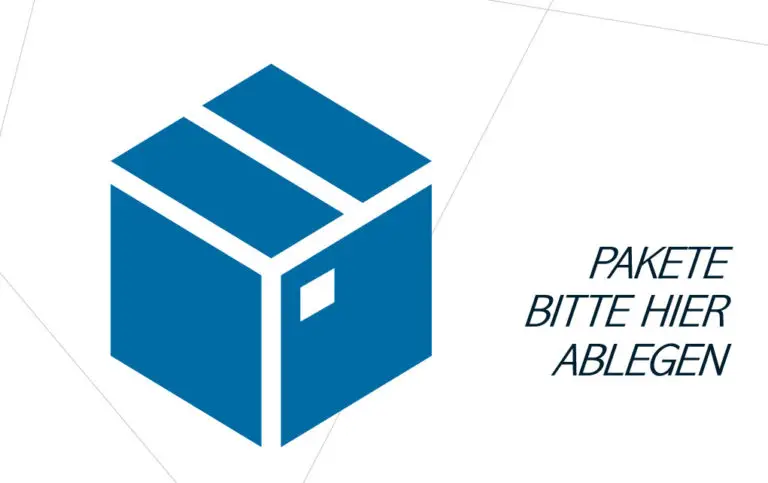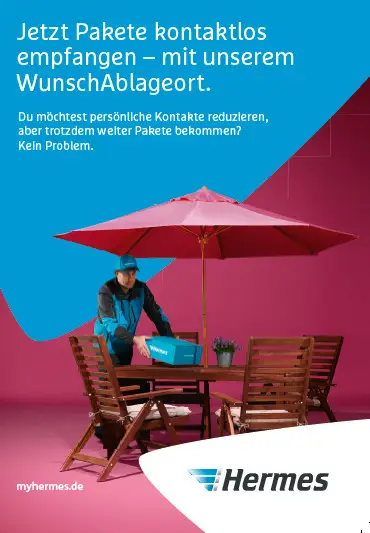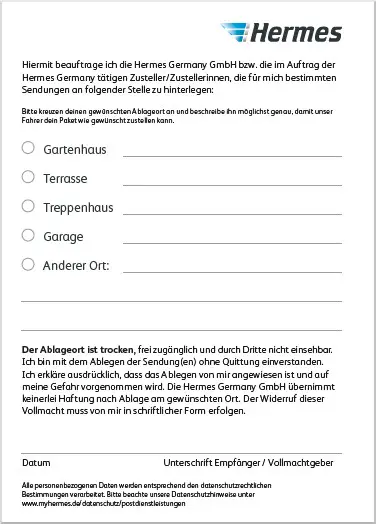Drop-off location on request - for more satisfied parcel customers
In order to offer Hermes customers time independence and the best possible flexibility when receiving parcels, customers across the country were to be informed about the new delivery on demand service. With this convenient service, recipients would in future be able to decide for themselves where their ordered goods would be delivered. The idea of a predefined and permanent drop-off location, such as a garage or a covered terrace, became an increasingly popular service among Hermes recipients.
At the time of introduction, however, the process of determining the filing location* yourself was still manual and very cumbersome. With the help of suitable direct marketing measures, the aim was to communicate the simplified handling to the desired target group. According to the motto: Simply specify the desired drop-off location and receive parcels on the first delivery attempt.
*Suitable storage locations include, for example, a garage, garden shed or covered terrace, all attributes that also played a key role in the data analysis.
Spatial finesse as a service
Not every customer has the opportunity to make use of the service. Certain requirements are necessary for parcel delivery. The campaign required target group-appropriate distribution. This is because only consignments that are deposited in a secure location on the property can replace personal delivery.
Targeted delivery by means of direct mail to affinity households in selected areas of Germany was intended to raise awareness of the service and thus increase the attention of recipients. The advertising material was designed so that the personal and permanent desired drop-off location could be specified without major effort and quickly and easily communicated to the Hermes customer center using a stamped return envelope.
Building-specific data was required in order to correctly translate the target group and address them to the exact house. Building criteria such as building type, garden type and size or the location of the house, combined with "meter-precise" geo-information on the possible desired drop-off location, were to ensure where the potential recipients with the suitable conditions for the offer of alternative drop-off locations could be found. Only a suitable selection of addressees who meet the requirements of a safe, visible and dry storage location could lead to the success of the advertising campaign without significant wastage.

Hermes Germany, based in Hamburg, is a leading logistics service provider in Germany and a partner to numerous online stores and multi-channel retailers in Germany and abroad. Hermes Germany focuses on national and international parcel delivery and the handling of upstream goods flows worldwide.
Hermes Germany is one of twelve companies in the internationally active Hermes Group, which is part of the Otto Group. The range of services offered by the companies operating under the Hermes brand covers the entire retail value chain: sourcing, quality assurance, transport, fulfillment, parcel services, two-man handling and global e-commerce services.
In the 2019/20 financial year, the Hermes Group increased its turnover to 3.5 billion euros. Hermes employs 15,563 people worldwide and is present in the most important European e-commerce markets.



Garage register for precise mailbox selection
Using Postwurfspezial*, a Deutsche Post service, the flyers were to be distributed exclusively to selected households in selected areas. This required appropriate potential counts and address selections as well as location-based analyses to ensure targeted delivery to individual homes. This required a comprehensive micro-geographical database with very specific target group and building criteria. Ideally selected and coordinated by a single service provider.
*Postwurfspezial are partially addressed advertising materials, e.g. "To the Hermes customers of House Musterstraße 1, 12345 Musterstadt" are distributed.
Based on the Nexiga house database with over 28 million buildings in Germany, particular attention was paid to the building characteristics of detached and semi-detached houses or terraced and semi-detached houses. The condition here was that these had to have a garage or storage facility (e.g. carport) within a radius of 5 meters. The Nexiga garage cadastre with more than 13 million properties with different parking facilities (garages, carports, multi-storey parking lots, etc.) was used as a secondary database. This was generated using a complex analysis process that also included the 65 million official 3D building perimeters from Nexiga.
Taking both databases into account, fine-tuning was carried out to filter out exactly those buildings that correspond to the typical character of a house with a garage. Building-specific data was required in order to correctly translate the target group and address them precisely.
Contactless delivery thanks to spatial intelligence
"By specifically addressing the right target group, we were able to significantly increase the rate of permanent drop-off at the desired location for all deliveries and thus not only guarantee our customers contactless delivery on the first delivery attempt, but also relieve the last mile in operational, budgetary and economic terms. And that's not all - our clients also benefit from the permanent drop-off location, as it enables them to increase their delivery rate."
Ann-Kristin Lipsky, Head of Marketing - Hermes Germany GmbH
Data basis
Building criteria such as building type, garden type and size or the location of the house, combined with "meter-precise" geo-information on the possible desired storage location, should ensure where the potential recipients with the suitable conditions for the offer of alternative storage locations can be found.
Only a suitable selection of addressees who meet the requirements of a safe, visible and dry storage location could lead to the success of the advertising campaign without significant wastage.
The successful path to guaranteed delivery
As sensitive data was requested from customers in order to ensure secure and contactless delivery, the expectation for the campaign was an already optimistic response rate of around 2%. This expectation was far exceeded.
The result 4 weeks after distribution was a response rate of between 3.3% and 8.2% - depending on the area.

- Optimization of the first delivery attempt
- Contactless, convenient delivery
- Relieving the last mile to reduce CO2 pollution
The goal of increasing customer satisfaction with the promise of "guaranteed delivery" has been achieved. The additional effect of reducingCO2 emissions at the same time not only pleases Hermes, but also the environment. The dynamic growth of online retail is one of the dominant factors in current consumer behavior and is increasingly pushing infrastructure and drivers to their limits.
Unnecessary journeys can only be avoided if the ordered parcels reach the customers, even if they are not at home. The offline campaign convinced numerous customers to use the contactless delivery service. In future, however, technical solutions will also be available for booking a desired drop-off location that interested parties can use online. Convenient and simple services are becoming increasingly popular for both ordering and delivery.
